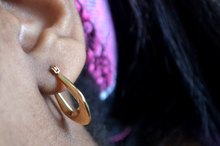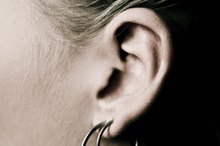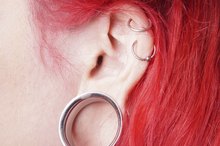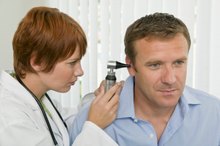What does fact checked mean?
At Healthfully, we strive to deliver objective content that is accurate and up-to-date. Our team periodically reviews articles in order to ensure content quality. The sources cited below consist of evidence from peer-reviewed journals, prominent medical organizations, academic associations, and government data.
The information contained on this site is for informational purposes only, and should not be used as a substitute for the advice of a professional health care provider. Please check with the appropriate physician regarding health questions and concerns. Although we strive to deliver accurate and up-to-date information, no guarantee to that effect is made.
What to Do When an Ear Grows Over the Back of an Earring
Getting your ears pierced can be a milestone event in your life. Unfortunately, earrings can sometimes become embedded in the ear, either because the ear gets infected and swollen, the earring clasp is too small or the earring is put on too tightly 1. When an earring becomes embedded, the earlobe grows over the back of the earring. The post of the earring may still be visible, but the clasp holding the earring in place is either partially or totally enclosed within the earlobe.
If you are experiencing serious medical symptoms, seek emergency treatment immediately.
Earring Clasp Is Partially Embedded
You may be able to remove an embedded earring at home if the ear shows no signs of infection such as redness or swelling, and if the earring is only partially embedded in the ear. Try numbing the earlobe with ice first to reduce pain. You don't want an infection to develop, so use rubbing alcohol on a cotton ball to clean your ear before you touch it, and be sure to wash your hands.
Turn the earring if you can to loosen it from the skin, then try to pull off the earring back. If you can't grasp the earring back with your fingers, try using tweezers that you've sterilized in rubbing alcohol.
If the earring will still not come out, call your doctor.
- You may be able to remove an embedded earring at home if the ear shows no signs of infection such as redness or swelling, and if the earring is only partially embedded in the ear.
- If you can't grasp the earring back with your fingers, try using tweezers that you've sterilized in rubbing alcohol.
Earring Clasp Is Totally Embedded or the Ear is Infected
How to Use Sleeper Earrings
Learn More
If the earring clasp is totally embedded within the ear—you cannot see the clasp at all—you need to visit a doctor to have the earring removed. Call your doctor as soon as you notice the earring is embedded: Waiting too long can cause an infection. The doctor will usually apply a local anesthetic and will then be able to push or cut out the earrings.
After-Care
After removing an embedded earring, you need to watch for signs of infection. If you had the earring removed by a doctor, the doctor will probably prescribe an antibiotic. If you were able to remove the earring yourself, apply an antibiotic cream regularly. If you see any signs of infection, call your doctor.
If you participate in any activities that might expose your ears to dirt as they're healing, cover your ears with bandages during the activity.
Allow your ears to heal completely before you consider having your ears repierced. It takes at least six to eight weeks for the holes to close up and the ear to heal. To prevent earrings from becoming embedded again, choose loop earrings with no clasps, or earrings with a large clasp 1.
- After removing an embedded earring, you need to watch for signs of infection.
- If you participate in any activities that might expose your ears to dirt as they're healing, cover your ears with bandages during the activity.
Related Articles
References
Writer Bio
Stacey Schifferdecker has worked as a professional writer since 1989. She holds a Master of Arts degree in English from Oklahoma State University. Schifferdecker has written and edited user guides, newsletters, brochures, curriculum, proposals, web copy, and ebooks.








